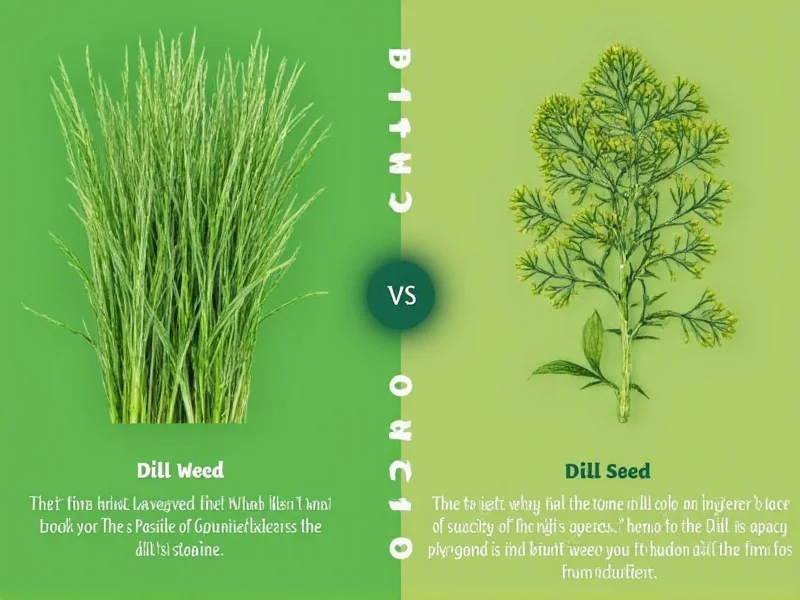Dill is a popular herb in many cuisines, but confusion often arises between dill weed and dill seed. Understanding the difference between fresh dill and dill seeds is essential for home cooks and professional chefs alike. While both come from the same plant, they're harvested at different stages of growth and offer unique characteristics that affect how they're used in cooking.
What Exactly is Dill Weed?
Dill weed describes the feathery green leaves and tender stems of the dill plant. When fresh, it has a delicate, grassy appearance with fine, thread-like foliage. The flavor profile of dill weed is bright, fresh, and slightly citrusy with subtle anise notes. Fresh dill weed offers the most vibrant flavor, while dried dill weed (often labeled simply as "dill") has a more concentrated but less complex taste.
Chefs typically add fresh dill weed toward the end of cooking or as a garnish to preserve its delicate flavor, which diminishes with prolonged heat exposure. This makes dill weed particularly valuable in dishes where its fresh character can shine through, such as in cold preparations or finished dishes.
Understanding Dill Seeds
Dill seeds are the mature, oval-shaped fruits that develop after the dill plant flowers. They start green and immature, eventually turning to a light to medium brown when fully ripe and dried. Unlike the delicate leaves, dill seeds have a stronger, more pungent flavor with distinct caraway-like and citrus notes, plus a slight bitterness.
The flavor of dill seed holds up well to cooking, making it suitable for dishes that require longer preparation times. When crushed or toasted, dill seeds release more intense aromatic compounds, which is why they're often used in pickling recipes, breads, and spice blends where their robust flavor can properly infuse throughout the dish.
Key Differences Between Dill Weed and Dill Seed
| Characteristic | Dill Weed | Dill Seed |
|---|---|---|
| Plant Part | Leaves and stems | Mature seeds |
| Appearance | Feathery green foliage | Small oval brown seeds |
| Flavor Profile | Fresh, grassy, citrusy, mild anise | Strong, pungent, caraway-like, slightly bitter |
| Best Used In | Fresh applications, finishing dishes, cold preparations | Pickling, baking, long-cooking dishes, spice blends |
| Heat Tolerance | Low - add at end of cooking | High - withstands prolonged cooking |
| Substitution Ratio | 1 tablespoon fresh = 1 teaspoon dried | 1 teaspoon seeds = 3 teaspoons dried weed (approximate) |
Culinary Applications Compared
When considering dill weed vs dill seed flavor comparison, their culinary applications differ significantly. Dill weed shines in applications where its fresh character can be appreciated without cooking:
- Salmon and seafood dishes (particularly gravlax)
- Dill dip and creamy sauces
- Cucumber salads and cold vegetable preparations
- Yogurt-based dressings and tzatziki
- Garnishing finished soups and stews
Dill seed's stronger flavor makes it ideal for recipes where its character can properly develop:
- Pickling cucumbers and other vegetables (essential for dill pickles)
- Bread recipes, particularly rye and sourdough
- Stews, soups, and braises that cook for extended periods
- Spice rubs for meats
- Homemade mustards and vinegars
Substitution Guidance: Can I Substitute One for the Other?
Many home cooks wonder if they can substitute dill seed for dill weed when a recipe calls for one but they only have the other. The answer is yes, but with important caveats about the dill seed substitute for dill weed question.
When substituting dill seed for fresh dill weed, use approximately 1/3 teaspoon of dill seed for every tablespoon of fresh dill weed. Remember that the flavor profile will change significantly - you'll gain the seed's stronger, more pungent notes but lose the fresh, grassy character of the weed.
Conversely, when substituting dried dill weed for dill seed, use about three times the amount of dried weed compared to the seed quantity called for. This dill weed to dill seed conversion isn't perfect because of their fundamentally different flavor compounds, so adjust to taste.
For the most authentic results, follow recipes as written when possible. Understanding when to use dill weed instead of dill seed can make a significant difference in your final dish's flavor profile.
Storage Recommendations
Proper storage differs for these two ingredients. Fresh dill weed should be treated like other delicate herbs: wrap in a slightly damp paper towel and store in a plastic bag in the refrigerator for up to one week. For longer storage, freeze fresh dill weed in ice cube trays with water or oil.
Dried dill weed maintains quality for 6-12 months when stored in an airtight container away from light and heat. Dill seeds have a longer shelf life, typically maintaining optimal flavor for 1-2 years when stored properly in a cool, dark place. To refresh slightly stale dill seeds, toast them lightly in a dry pan before use to revive their aromatic compounds.
Nutritional Differences
While both come from the same plant, dill weed and dill seed have different nutritional profiles. Fresh dill weed is primarily water with small amounts of vitamins A and C. Dill seeds contain more concentrated nutrients including calcium, iron, magnesium, and dietary fiber. However, since seeds are used in smaller quantities than the weed, the actual nutritional contribution to dishes differs significantly.











 浙公网安备
33010002000092号
浙公网安备
33010002000092号 浙B2-20120091-4
浙B2-20120091-4